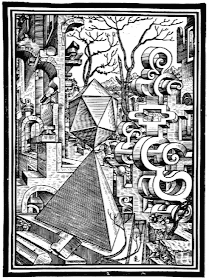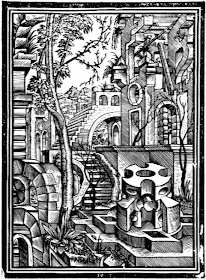 I’ve written about eponyms before: those words that derive from proper nouns. Usually we think of the ones with etymologies from people’s names, but I also listed some that come from brand names. Today I’ve got another list of eponyms, this time words that derive from the names of places.
I’ve written about eponyms before: those words that derive from proper nouns. Usually we think of the ones with etymologies from people’s names, but I also listed some that come from brand names. Today I’ve got another list of eponyms, this time words that derive from the names of places.denim - c.1690 from serge de Nimes, but as the modern type of coarse cotton cloth the word dates to c.1850
buckram - early 13th c, from Old French (possibly by way of Italian), from Bukhara, Uzbekistan. (At least, it may be - like so many etymologies, this is uncertain.) Originally a delicate fabric, it’s now the coarse fabric used for bookbinding and millinery.
madras - 1833, bright-colored muslin from the Indian state now called Chennai (In an interesting side note, the emphasis is generally on the first syllable for the fabric even though it’s on the second syllable for the place name.)
shantung - 1882, coarse silk named for the Chinese province where it was made
There are also many articles of clothing with names derived from places.
jeans - Originally a fabric from Genoa, Italy (or, as the French call it, Gênes), the word now usually refers to the particular style of trousers introduced by Levi Strauss and Jacob Davis in 1873. Strauss didn’t start calling their product “jeans” until 1960.
dungarees - Also originally a fabric (early 17th century) before it became a garment (c.1868) from the name of a village now part of Mumbai, India.
bikini - 1948 from French, named for Bikini in the Marshall Islands, where the US tested the A-bomb. The origin isn’t entirely clear, but it’s presumed to be because of the explosive impact of the bathing suit on viewers.
cravat - 1650s, from French, from German, from Serbo-Croation Hrvat for “Croat”, the neckwear was copied from a scarf worn by Croation mercenaries in the French army.
jodhpurs - 1899 as jodhpur breeches, from a former state in northwest India
Other products are also named for their city or place of manufacture, including some that are well-known, such as
cologne - 1814 from the French name for Köln, Germany
And others that are more surprising, such as
badminton - 1874 from the Gloucester estate of the Duke of Beaufort. Here the game was first played in England (by British officers who had encountered it under the name poona in India).
bayonet - 17th c, possibly from Bayonne, France, where the daggers may have been first made or first stuck on the ends of guns - but also possibly a diminutive of Old French bayon “crossbow bolt.” You never know.
And finally, a bonus oddity
magenta - The analine dye that introduced this color to the world as a specific hue was invented/discovered in 1859, and named for Magenta, Italy to commemorate the Battle of Magenta in which the French and Sardinians had just defeated the Austrians.
What I find so delightful about discovering the eponymous origins of these words is the evidence of just how interconnected the world really was, even as far back as the thirteenth century. But at the same time, I enjoy the reminder that even though products from faraway places might have been available, they were considered exotic and special, not ubiquitous and taken for granted. The world may have been interconnected, but it wasn’t homogenized. The fabric from Nimes wasn’t the same as fabric made elsewhere. Cologne was made in Köln, not in factories anywhere and everywhere. So what sort of special regional products do we enjoy today? Foods, certainly, but keep your eyes open and see if you notice others.
[Pictures: Silk weaving, hand painted wood block cut by Zhu Gui from Imperially Commissioned Illustrations of Agriculture and Sericulture, 1696 (Image from The British Museum);
Genoa (Genua), woodcut from the Nuremberg Chronicle, 1493;
Köln (Colonia), woodcut from the Nuremberg Chronicle, 1493 (Images from Wikimedia Commons).]




















